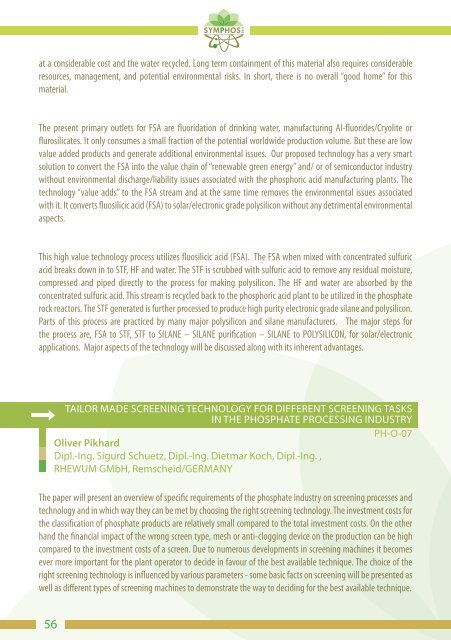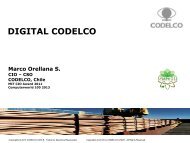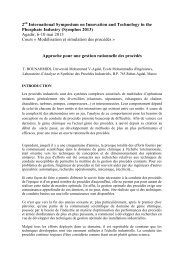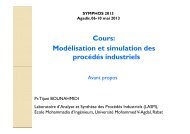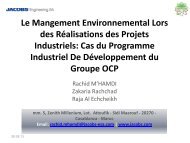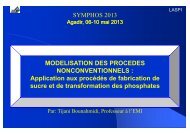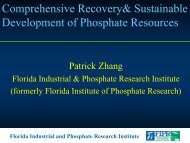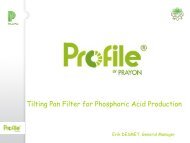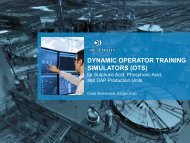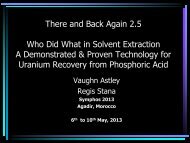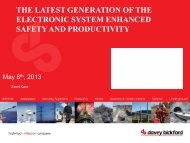Abstract SYMPHOS 2011
Abstract SYMPHOS 2011
Abstract SYMPHOS 2011
You also want an ePaper? Increase the reach of your titles
YUMPU automatically turns print PDFs into web optimized ePapers that Google loves.
at a considerable cost and the water recycled. Long term containment of this material also requires considerable<br />
resources, management, and potential environmental risks. In short, there is no overall “good home” for this<br />
material.<br />
The present primary outlets for FSA are fluoridation of drinking water, manufacturing Al-fluorides/Cryolite or<br />
flurosilicates. It only consumes a small fraction of the potential worldwide production volume. But these are low<br />
value added products and generate additional environmental issues. Our proposed technology has a very smart<br />
solution to convert the FSA into the value chain of “renewable green energy” and/ or of semiconductor industry<br />
without environmental discharge/liability issues associated with the phosphoric acid manufacturing plants. The<br />
technology “value adds” to the FSA stream and at the same time removes the environmental issues associated<br />
with it. It converts fluosilicic acid (FSA) to solar/electronic grade polysilicon without any detrimental environmental<br />
aspects.<br />
This high value technology process utilizes fluosilicic acid (FSA). The FSA when mixed with concentrated sulfuric<br />
acid breaks down in to STF, HF and water. The STF is scrubbed with sulfuric acid to remove any residual moisture,<br />
compressed and piped directly to the process for making polysilicon. The HF and water are absorbed by the<br />
concentrated sulfuric acid. This stream is recycled back to the phosphoric acid plant to be utilized in the phosphate<br />
rock reactors. The STF generated is further processed to produce high purity electronic grade silane and polysilicon.<br />
Parts of this process are practiced by many major polysilicon and silane manufacturers. The major steps for<br />
the process are, FSA to STF, STF to SILANE – SILANE purification – SILANE to POLYSILICON, for solar/electronic<br />
applications. Major aspects of the technology will be discussed along with its inherent advantages.<br />
56<br />
TAILOR MADE SCREENING TECHNOLOGY FOR DIFFERENT SCREENING TASKS<br />
IN THE PHOSPHATE PROCESSING INDUSTRY<br />
PH-O-07<br />
Oliver Pikhard<br />
Dipl.-Ing. Sigurd Schuetz, Dipl.-Ing. Dietmar Koch, Dipl.-Ing. ,<br />
RHEWUM GMbH, Remscheid/GERMANY<br />
The paper will present an overview of specific requirements of the phosphate industry on screening processes and<br />
technology and in which way they can be met by choosing the right screening technology. The investment costs for<br />
the classification of phosphate products are relatively small compared to the total investment costs. On the other<br />
hand the financial impact of the wrong screen type, mesh or anti-clogging device on the production can be high<br />
compared to the investment costs of a screen. Due to numerous developments in screening machines it becomes<br />
ever more important for the plant operator to decide in favour of the best available technique. The choice of the<br />
right screening technology is influenced by various parameters - some basic facts on screening will be presented as<br />
well as different types of screening machines to demonstrate the way to deciding for the best available technique.


